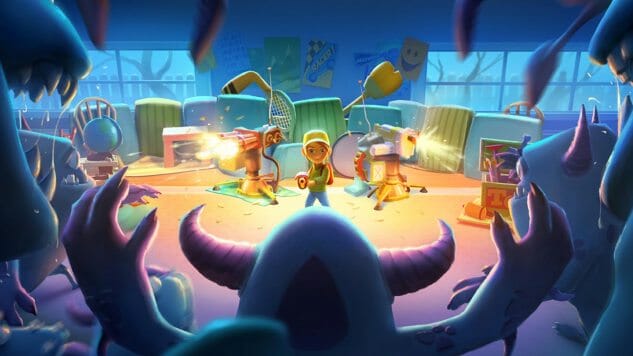Ah, tower defense games. Once upon a time, I actually had time to play them. In fact, I used to be pretty good at Orcs Must Die!—and by that I mean I was charted in the top 1000 in one of the levels of Orcs Must Die! 2. It’s not a huge accomplishment, but it does attest to the amount of hours I was willing to put into the game despite how rare it is that I get to play anything just for fun.
Which is to say that generally, tower defense games have a rough learning curve, as it takes some time to fully earn and understand the full range of their traps and weapons. But that’s what makes them so fun, right? The promise that you’ll do better on the next run, that celebratory high after finishing a successful wave, and the Pandora’s box of what secret or trick you might learn that makes you all powerful and invincible. Recently I had that experience again with Sleep Tight, a fun little one-player game that injects tower defense strategy into the oversized imagination of childhood. In it, you star as a young hero defending their room from late night hordes of monsters. As you survive each night, you gain currency to spend on things like turrets or pillow fortress walls or new weapons, each holding the promise of helping you survive another night—if you can balance all your resources just right.

What’s especially enjoyable about Sleep Tight is that it turns a major childhood fear—that of monsters in your bedroom at night—into a game, one where the premise and mechanics together are a such a natural fit. And fittingly, the simplicity is suited for those still in their childhoods. While many games, like the aforementioned Orcs Must Die!, are complex in the many character powers or traps or other means of combat and defense, Sleep Tight keeps it modest. Turrets and pillow walls will be your primary means of holding off the hordes. Collecting Stars (from the monster drops) and Suns (from surviving another night) will let you reup ammo and health and shields. Investing currency into research will allow for some boosters to build up your performance in small layers. Like Plants vs. Zombies, the aesthetic and premise are packaged for kids, but still appealing and challenging for adults. And also like Plants vs. Zombies, the systems are not overwhelmed with dizzying amounts of statistics and damage and decay rates. For those who do not like to be bogged down by keeping too many rules in the balance, but still like the action of a tower defense game, Sleep Tight is a less stimulating place to begin, allowing for a more gradual absorption of all the many factors at play.
Even now, as I write this, I have many hours to play in Sleep Tight before I really craft the strategy and resource balance most ideal to my skill sets. Not because I haven’t played it that much, but more because I’m thorough. There’s still an irresistible urge to pick it apart piece by piece and put it back together ‘til I never fear the creatures emerging from each shadowy corner again. Funny enough, as my young niece watched me play the game, she had that desire too (in the process entertaining several dark theories about what kind of parents leave their kid to fend for their lives in the middle of the night). It was a conflict she understood, and the cool character designs didn’t hurt either. If you have a child in your life, scoop ‘em up in your lap and teach them how to play Sleep Tight.
Holly Green is the assistant editor of Paste Games and a reporter and semiprofessional photographer. She is also the author of Fry Scores: An Unofficial Guide To Video Game Grub. You can find her work at Gamasutra, Polygon, Unwinnable, and other videogame news publications.

